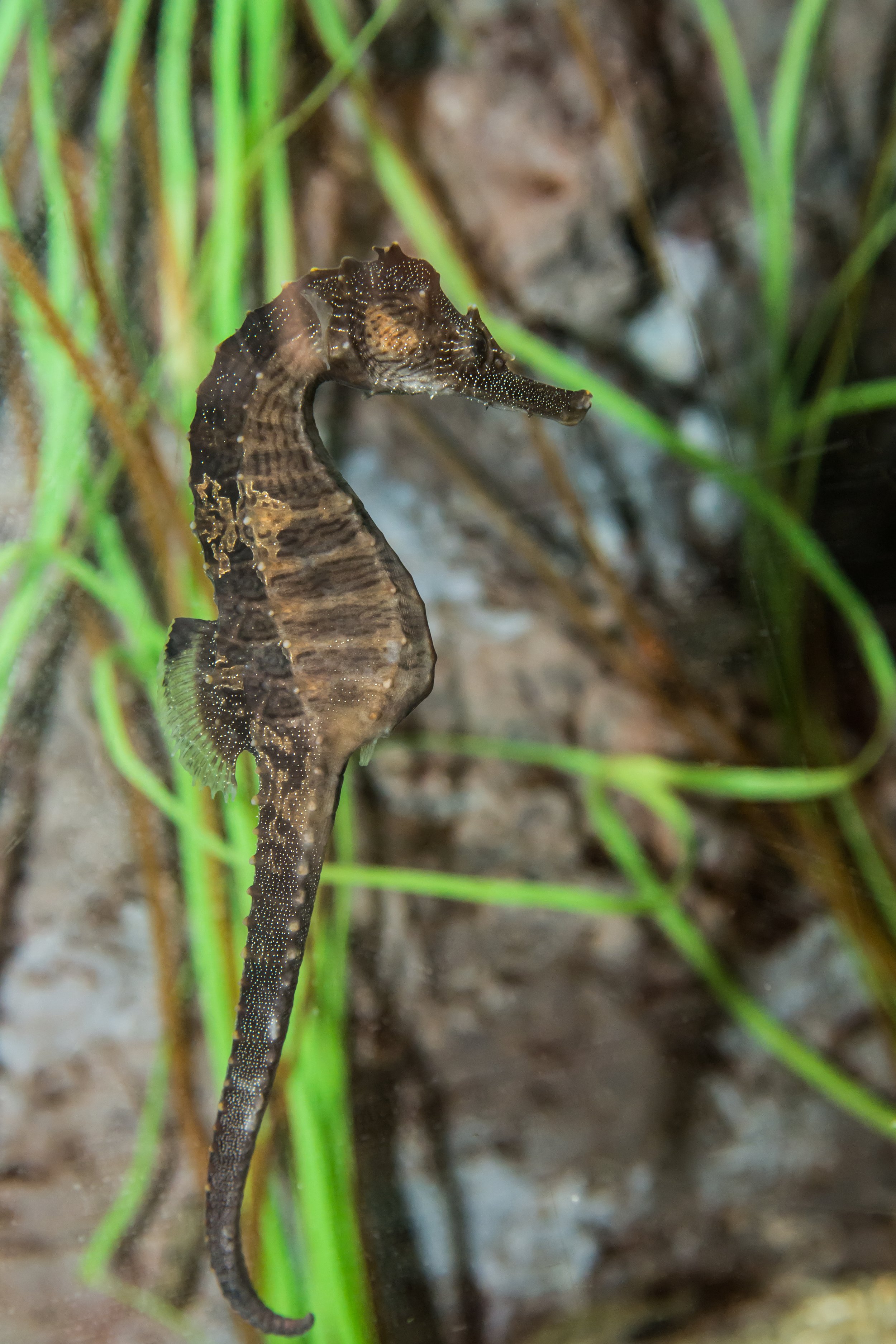Where Do Seahorses Go For The Winter?
By Jenna Reynolds
Director
Save Coastal Wildlife Nonprofit
Northern Lined Seahorse (Hippocampus erectus) the only native seahorse species to be found along the Jersey Shore.
Where do Seahorses go for the winter? Hint: they don’t go south for the winter like birds. Read on.
Many Monmouth County residents may not know that seahorses live along the Jersey Shore. In fact, nearly every bay or estuary and even the Atlantic Ocean during the summer may contain several populations of this fascinating and delicate sea creature.
An adult seahorse found along Sandy Hook Bay during a summer fish survey in 2012.
Why can’t seahorses easily be found? Seahorses are some of the most elusive and hard to find sea creatures in the northeast. Throughout the more than 20 years of fish survey events along the Jersey Shore that members of Save Coastal Wildlife Sandy have conducted we have only caught a handful of seahorses in our seine net. In every case, they were single adults in search of a mate.
Why are seahorses difficult to discover? For starters, they are some of the tiniest adult fish around. The average length of an adult seahorse is just 3.9 inches. The Satomi's pygmy seahorse, which lives near Indonesia and Malaysia, is the smallest seahorse in the world at only half an inch long.
Seahorses are also masters of disguise. Just like octopuses and cuttlefish, they can change the color and the texture of their skin to match their surroundings and blend in easily to escape predation. Tiny organs in their skin contain several pigments that can expand or contract in response to a variety of stimuli, causing seahorses to change color.
Yellow, black and reddish-brown. Northern Lined Seahorses can change the color of their skin depending on their mood and local environment to escape predation.
The Northern Lined Seahorse (Hippocampus erectus) is the only native seahorse to be found along the Jersey Shore. This unique fish can grow between 5 to 6 inches in length. It varies in color from pale yellow to nearly black depending on its surroundings. Like many other species of seahorses, they have a horse-like head and a long snout with a small, toothless mouth at the end, and a tapered tail without a fin.
During the summer, lined seahorses live among the underwater grasses, oyster beds or piers and pilings from Raritan Bay down to Delaware Bay. They feed mostly on tiny crustaceans including amphipods and copepods. Seahorses regularly surprise their prey by changing color to match their environment and then wrapping their long tail around an object to stay very still. A seahorse will attack and suck its petite prey into its long, tubular snout, which can consume up to 3,000 crustaceans in a single day.
Seahorses are undoubtedly best known for their monogamist nature, and lined seahorses are no exception. Our local seahorse population will roam the Jersey Shore alone until it finds a mate. Once coupled, the two seahorses will stay together for a long period of time – often forever. Males have a distinct brood pouch on the front of their body, which is used by female seahorses to place their small pear-shaped eggs into the male’s body. During gestation, males will often settle into a remote area to rest and protect the eggs from predators, which can last between 12 to 14 days.
Distinguished marine biologists Kenneth W. Able and Michael P. Fahay in their book, Ecology of Estuarine Fishes: Temperate Waters of the Western North Atlantic (published by The John Hopkins University Press, 2010), tell us from their research on lined seahorses in South Jersey waters that the breeding season is generally from May to October. Reproduction begins in May and reaches a peak in July and stays relatively high through September. The males they discovered had as many as 1,515 embryos in their pouch.
Baby seahorses are called fry and once born, they are completely independent. Mom and dad leave them to find food and shelter all on their own. In fact, the male seahorse is not responsible for any of the upbringing of the offspring leaving them vulnerable to predators. This is why repeated reproduction is important for seahorses. NOAA fisheries states on their webpage entitled “How do seahorses differ from all other animals?” that large litters of a thousand or more babies born from just one father is necessary because only about 0.5 percent will survive to adulthood. Seahorse predators include crabs, sharks, skates, rays, and larger fish.
At just about 0.1 inches long, the young seahorses are recognizable by their unique body shape and look like small adult seahorses. Maturity is reached at lengths of 2.2-2.8 inches with males developing brood pouches at 5-7 months of age. The lifespan of the lined seahorse is approximately one year.
Thanks to the difficult work of many marine biologists and citizen scientists, we have a good idea on the lives of lined seahorses during the warmer months of the year.
Yet, many questions still need to be answered on what happens to seahorses during the winter?
An adult Northern Pipefish found during a Save Coastal Wildlife Fish Survey along the Jersey Shore.
Some research suggests that lined seahorses migrate offshore from the Jersey Shore to deeper waters in the Atlantic Ocean during the colder months of the year. This migration pattern is similar to the Northern pipefish (Syngnathus fuscus), which are closely related to seahorses.
Marine researchers Mark A. Lazzari and Kenneth W. Able in their journal article entitled, “Northern pipefish, Syngnathus fuscus, occurrences over the Mid-Atlantic Bight continental shelf: evidence of seasonal migration” (1990) indicate from their studies in the north Mid-Atlantic Bight that northern pipefish undergo seasonal, inshore-offshore migrations. During spring through fall, the pipefish are residents in estuaries, but move into nearshore continental shelf waters off Cape Cod in late September and October, and off Long Island and New Jersey in November.
A population of seahorses seem to be following the influence of their cousins the pipefish and making a long-distance migration out to the ocean every winter. Able and Fahay state that an uncertain number of lined seahorses, including young seahorses, are making an annual inshore to offshore migration, west to east, as opposed to north to south, to primarily escape rough winter weather.
The Continental Shelf. Image from National Oceanic and Atmospheric Administration (NOAA), NOAA explorers discover deepwater gas seeps off U.S. Atlantic coast (December 19, 2012).
From research of seahorses between North Carolina and Long Island, Able and Fahay found that from November to March, most of seahorses they collected were from the ocean, located out to the inner and mid continental shelf in water depths between 68 feet to 224 feet. In the spring, seahorses were discovered primarily at the inner shelf at depths of 26 feet to 260 feet. Able and Fahay reported that during the winter, at sea temperatures of 51 degrees Fahrenheit, seahorses were observed by deep sea divers on the inner continental shelf off Long Island, where the seahorses laid motionless on the ground.
It seems at least a particular population of lined seahorses may make a long-distance migration to school in the deep areas of the continental shelf and take a "winter rest." In this resting state, the hearts of seahorses slow down, their needs for food and oxygen decrease, and they move about very little.
In other parts of the world, various species of seahorses also make inshore to offshore migrations. In the northwestern Pacific Ocean along the coast of China, seahorses will make long-distance migrations to the ocean to breed, while seahorses along the British Isles will move in and out of estuaries to feed on plankton rich waters from the Gulf Stream.
What makes this inshore to offshore migration really interesting is that seahorses are ridiculously poor swimmers.
Seahorses are thought to have developed from pipefish, and while pipefish are strong swimmers, seahorses are not.
Author Liz Langley in her National Geographic article entitled: Why some fish are really bad at swimming (2018), reveals that seahorses are the slowest moving of all fish species. Seashores move at a maximum speed of about 1.6 yards per hour. For comparison, some snails can reach 3.2 yards per hour.
Seahorses move so slowly due to having primarily one small fin located in the middle of their backs. This tiny dorsal fin is the only way seahorses have to propel themselves forward to a high speed of 1.5. mph or as low as 0.01 mph!
Seahorses have a long tail, perhaps all the better to hitchhike in the ocean.
Although this hind fin can beat back and forth up to 50 times a second, the size of the fin keeps it from making much progress when it comes to distance traveled. Even with small pectoral fins that assist in steering, seahorses are known to be so delicate that they can become fatally exhausted when waters get rough during intense storms.
So how do seahorses make it all the way from the shallow waters of the Jersey Shore to the deep offshore waters of the Atlantic Ocean?
No one knows for sure, but some scientists have theorized that seahorses are really good at hitchhiking. Author Katie Hogge from the Ocean Conservancy states that while seahorses may not be able to travel long distances quickly, connecting themselves onto floating vegetation or other debris can improve the journey and take them back and forth from the ocean to a bay. Their tails are quite flexible, which can enable seahorses to anchor themselves to floating fragments when they’re in need of a rest or to move around swiftly.
How many lined seahorses make the journey from the Jersey Shore to deeper ocean waters is uncertain at this time. It would not be surprising, though, if some seahorses remain in local bay waters throughout the year. Lined seahorses in Chesapeake Bay for example, are thought to remain in home waters all winter, but will retreat to deeper ship channels within Chesapeake Bay.
Not all seahorses survive the inshore-offshore migration every fall or spring. If you ever found a dead seahorse on an Atlantic Ocean beach, chances are good it died from a stressful migration due to rough seas and intense weather.
The lined seahorse is listed by the World Conservation Union (IUCN) Red List as “Vulnerable,” meaning the future of this species is uncertain. Indirect evidence shows that numbers are continuing to decline, which has raised concern. Threats to lined seahorses include habitat loss, pollution, climate change, invasive species, and direct exploitation in the form of overfishing and bycatch. This species is also targeted within the aquarium and souvenir trade fishery.
On the global scale, at least 14 seahorse species are threatened, while the status of another 17 species are unknown, and labelled as Data Deficient according to the IUCN.
What can you do to save seahorses?
In New Jersey, we need to make the collecting of seahorses illegal!!!
In 2011 Huntington-Oyster Bay Audubon Society led a successful lobbying effort in New York State to protect Northern or Lined Seahorses ( Hippocampus erectus) through the adoption of state legislation prohibiting the commercial harvest of seahorses. The legislation, an amendment to the NY State Environmental Conservation Law, does allow for the collection of seahorses for educational and scientific purposes. The legislation was adopted to stop the harvest and exploitation of northern seahorses for the pet trade. Seahorses generally do not do well as an aquarium pet, suffering high rates of mortality. The measure became Chapter 81 of the Laws of 2011 when Governor Cuomo signed the measure into law on June 22nd.









